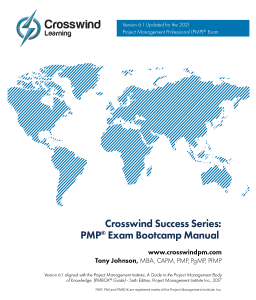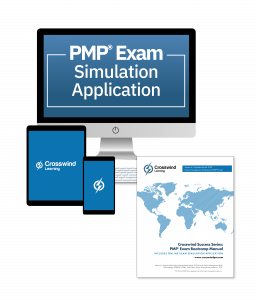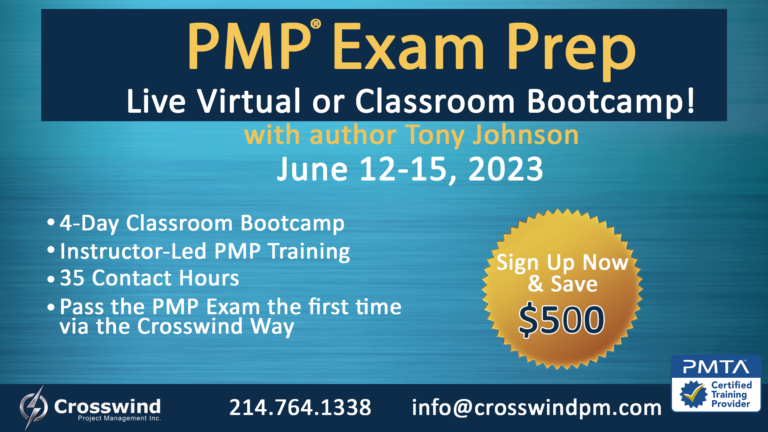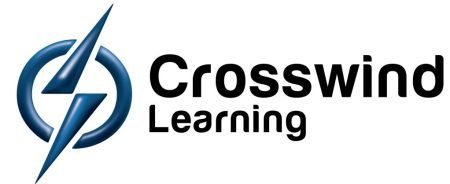Free PMP Terms and Definitions
Understanding common project management terms can be a challenge for all project managers. To help you understand those terms and definitions Crosswind Project Management has created a free to use glossary to help in your pmp training. In this page you will find the terms and definitions associated within the component areas of framework to get a better understanding of how this process works and relates to project management.
Sign Up for a daily free Tip of The Day!
| Term | Definition |
|---|---|
| 80/20 Rule | A rule of thumb that has many applications, but generally implies that 80% of problems or defects come from a small number (20%) of causes. |
| A/B Testing | A marketing tool where users are given two different options with one independent variable, to see which they prefer. |
| Acceptance Criteria | Customer identified functionality written in enough detail to validate product performance; objective criteria that determines if the story achieves the value it represents |
| Acceptance Test | Activities that validate that the features perform in accordance with customer defined functionality |
| Accuracy | The degree of correctness within a quality system |
| Administrative Closure | Task associated with the verification and documentation of project results, to formally close the project or phase. |
| Attribute Sampling Data | Data that is counted to analyze, create charts/graphs, and support decision making. |
| Auditing | A formal review of the project's characteristics including purpose, results, metrics, and documentation, among other parameters. |
| Benchmarking | Technique of measuring performance against the best-in-class; often involves determining the processes used by best-in-class to achieve that status and applying those processes to effect improvement |
| Cause and Effect Diagram | A decomposition approach used to identify the root cause of a problem; also known as a fishbone or Ishakawa diagram |
| Checksheets | A sheet that can be used as a checklist when gathering data |
| Close Project or Phase | The process of completing each activity across all process groups in order to finalize a project or phase |
| Close-Out Meetings | Meetings held at the end of the project to review project work, and to capture lessons learned. (Sometimes called lessonsn learned or retrospectives.) |
| Conformance | Within the quality management system, the delivery of a product or result that falls within the acceptable tolerance levels of quality requirements |
| Continuous Improvement (CI) | Daily inspection and adaption performed to bring greater efficiency and effectiveness to the workplace |
| Control | The process of contrasting actual performance to planned performance, assessing the resulting variances, and determining the actions that will improve performance levels |
| Control Chart | A graphic representation of process data over time that is set against documented control limits and has a center line (mean) to assist in identifying trends |
| Cost of Conformance | A proactive approach, spending money on quality with a project to attempt to design out defects before they arise. Any type of proactive spending can be included to eliminate potential defects and maximize the customer experience with the product. |
| Cost of Nonconformance | Cost associated with not meeting quality expectations of the project or product |
| Cost of Quality | The total cost of achieving or failing to achieve desired quality: specifically the costs of achievement are those associated with planning, controlling, and assuring quality and the costs of failure are those associated with reworking, warranty, waste, and negative reputation |

Crosswind’s 35 Contact Hour PMP Exam Prep Course Bundle offers the best PMP certification training. This 4 day course is taught by author Tony Johnson will help you pass the PMP Exam the first time via the Crosswind Way!
| Term | Definition |
|---|---|
| Cost Performance Index (CPI) | The ratio indicating the cost efficiency of resources, calculated by dividing earned value (EV) by actual cost (AC): a CPI of 1.0 indicates the project is proceeding as planned; a CPI greater than 1.0 more indicates the project is proceeding better than planned; and a CPI less than 1.0 indicates the project is not proceeding as well as planned |
| Cost Variance (CV) | The difference between the value of what was built (earned value) and the cost of what was built (actual cost) |
| Criteria | Standards applied to a product, service, result, or process in order to make a decision or render a judgment about that product, service, result or process |
| Debriefing | A more casual approach to lessons learned on a project to help the organization evolve and improve future projects. |
| End-to-End Test | Investigation of the entire software environment under conditions that replicate actual usage, such as any interactions with databases, other applications, and/or other systems |
| Estimate at Completion (EAC) | The estimated cost of all the project work based on the actual cost of work done plus the estimated costs of work remaining |
| Estimate at Completion (EAC) | The estimated cost of all the project work based on the actual cost of work done plus the estimated costs of work remaining |
| Estimate to Complete (ETC) | The expected monetary resources required to complete the remaining work of the project; calculated by subtracting actual cost (AC) from the estimate at completion (EAC) |
| Estimate to Complete (ETC) | The expected monetary resources required to complete the remaining work of the project; calculated by subtracting actual cost (AC) from the estimate at completion (EAC) |
| Five Whys Activity | The practice of asking a series of questions as a method of uncovering the source of an issue |
| Formal Acceptance | Attaining signature for a piece of the project or the complete project, where the signature represents completion or closure of the project or that piece of the project |
| Grade | A ranking to classify products that have different functions or features |
| Histogram | A graphical representation, in the format of bar chart, that depicts the central tendency, dispersal, and shape of a statistical distribution |
| Influence Diagram | A graphical representation of relationship between variables and outcomes including situations with causal influence and event time sequences |
| Key Performance Indicator (KPI) | A metric or measurement used to compare a team's performance to the project's vision and goals. |
| Lessons Learned | The knowledge of what worked and what didn't work during a project |
| Lessons Learned Register | A project document utilized to record knowledge gained, both positive and negative, during the project; the information contained in register can be used in the current project and entered into the lessons learned repository for use with future projects. |
| Matrix Diagrams | A quality management tool that analyzes data by showing relationships between the data |
| Measurement Performance Domain | The performance domain associated with project performance including assessing performance and maintaining acceptable performance levels. |
| Measures of Performance | Measures that show physical or functional attributes related to system or application operation. |

Crosswind 2022 PMP Exam Bootcamp Manual
The PMP Exam Bootcamp Manual provides a foundation for the PMP Exam. This manual comes with a complete 200 question exam simulation application and 50/100 question ITTO exams created with over 1,400 ITTO questions in the data base.
| Term | Definition |
|---|---|
| S-curve | Graphic representation of costs, work, and other quantities over time so that the planned value, earned value, and actual cost of the work can be seen |
| Scatter Diagram | A graphical representation that shows the relationship between two variables by putting one on an x axis, the other on a y axis, and analyzing the intersecting points; typically used to determine root causes or the presence of a cause and effect relationship |
| Schedule Performance Index (SPI) | A measure of project schedule efficiency calculated by dividing the earned value (EV) by the planned value (PV): a value of 1.0 indicates the work is being performed as expected, a value greater than 1.0 means the work is being performed ahead of schedule, and a value of less than 1.0 means the work is being performed behind schedule |
| Schedule Variance (SV) | A determination of schedule performance calculated by subtracting the planned value (PV) from the earned value (EV): if the result is zero, the project is performing as expected; if the result is positive, the project is ahead of schedule; if the result is negative, the project is behind schedule |
| Seven Basic Quality Tools | A group of devises used by quality management for quality planning and for monitoring and controlling |
| Sigma | A measurement of acceptability of a product or process |
| Six Sigma | A highly structured methodology focused on accelerating process performance and diminishing process variations in order to improve quality and profits, while reducing defects |
| SMART Goals Activity | Objectives that are specific, measurable, attainable, relevant, and timely |
| Specification | An instrument that effectively defines the requirements, design, characteristics, and other attributes of a system, component, product, result or service and typically provides for procedures to determine that the provisions of the instrument have been met |
| Statistical Sampling | The selection of a part of a population for examination rather than using the entire population |
| Status Meeting | A regularly scheduled meeting that facilitates updating the team and relevant stakeholders on the current state of progress on the project. |
| Status Report | A report that states the current shape or state of the project to date |
| Technical Performance Measures | Measurable performance criteria established to ensure system components fulfill the technical requirements. |
| Test Plan | A document that describes what deliverables will be tested, what tests will be performed, and any related processes associated with testing. |
| Threshold | Any value (typically applied to cost, time, quality, technical, or resource) that is used as a parameter; typically crossing the threshold results in a triggered action |
| To Complete Performance Index (TCPI) | The ratio that represents the cost performance required to complete the work of the project given the remaining resources; calculated by dividing the remaining project work by the remaining budget (BAC - EV/BAC - AC) |
| Tolerance | The measure of acceptable variation |
| Total Quality Management (TQM) | A quality management philosophy that approaches quality management proactively and applies statistical sampling to help document improvements. |
| Trend Analysis | An analytical technique that uses mathematical paradigms to predict future outcomes based on historical data |
| Unique Identification Code | A subset of the code of accounts that allows assignment of a unique number to pieces of the WBS or other work decomposition. |

Crosswind PMP Prep Bootcamp Manual and Premium PMP Exam Simulator Bundle 2022 Exam
With over 4,800 questions and 130 different test options available, The Crosswind PMP Exam Simulation Application is the most detailed Project Management Professional (PMP)® exam product on the market. Quizzes are available by knowledge area and exam domains as well as calculations, terminology, definitions. For added initiative, the exam allows you to randomize your questions and answers to keep every test unfamiliar and applicable. Attack the exam with confidence and competency. Success is yours when you work with Crosswind!
| Term | Definition |
|---|---|
| Phase Gate | A review which is conducted at the end of a phase to decide if the project should continue to the next phase, if the project should continue to the next phase with modification, or if the project or program should be terminated. |
| Planning Process Group | The processes required to create the management and other planning documents that comprise the project management plan |
| Predictive Life Cycle | A life cycle type that determines project scope, time, and cost during the early phases of the life cycle. |
| Product Life Cycle | The phases of product development, typically defined as conception through delivery, expansion, maturity, and disengagement |
| Product Roadmap | The description of how the project will proceed from its current state to the state described in the vision statement |
| Progressive Elaboration | The iterative process of increasing the level of detail in accordance with the increase in information discovery and estimation accuracy |
| Project Life Cycle | The phases, from initiation through closure, of a project associated with the work of the project, as opposed to being associated with its project management |
| Project Management Process Group | The aggregation of the processes, along with their inputs, outputs, tools, and technique, that make up project management including initiating, planning, executing, monitoring and controlling, and closing |
| Project Phase | An aggregation of logically related activities that results in the completion of a deliverable or deliverables |
| Project Vision Statement | A document that defines the goal of the project, typically referencing the target customer, the need or opportunity, and the key benefit; often includes the main alternative to the project and why the project goal is more desirable |
| Relative Authority | The authority that the project manager has relative to the functional manager's authority over the project team and project environment. |
| Release | A deployable software package that incorporates several iterations |
| Release Management | Activities performed to ensure that the software is ready for release to the customer |
| Release Plan | A plan that defines iterations, dates and features or outcomes to be delivered over multiple iterations. |
| Release Planning | Defining the prioritized and estimated stories from the product backlog that will be developed in the release and determining the date of the release |
| Roadmap | A document that contains the high-level plan of the features that will be developed during the next few releases; the product owner/customer owns and maintain the document |
| Rolling Wave Planning | Preparing in more detail as the project becomes clearer |
| Scrum | An Agile methodology that delivers finished increments of a product at the end of each Sprint (a timeboxed iteration with a duration of one to four weeks) |
| Scrum of Scrums | A planning forum used in multiple-team projects to coordinate resources and dependencies |
| Scrum Values | Openness, focus, commitment, courage, visibility, and humor |

Crosswind 2022 PMP Prep System
The Crosswind PMP Exam Prep Certification Study System provides everything you need in order to transform your studying into a successful testing experience. Obtain your PMP certification with ease using this comprehensive study system. Aligned with the 2022 PMP Exam Content Outline (ECO).
| Term | Definition |
|---|---|
| Unit Test | Activities that validate the smallest testable parts of the system |
| Use Case | A document that defines how the user will interact with the product and how the product will respond to the user |
| User Acceptance Test (UAT) | Activities that validate that the product behaves in accordance with the user stories |
| Validate Scope | The process in which the customer or sponsor reviews and accepts project deliverables as being complete and correct in accordance with the requirements |
| Validation | The process of determining that the results of the project are in compliance with requirements imposed by the customer and appropriate stakeholders and typically involving acceptance by them |
| Vanity Metric | A metric that appears to show some kind of outcome, but is not really helpful in making decisions. |
| Variable Sampling Data | Sample data that is measured continuously, such as duration, temperature, length, and weight. |
| Variance | Any difference between a planned value or baseline and an actual result |
| Variance Analysis | The assessment of the level and reasons for a variance from planned value or baseline |
| Variance At Completion (VAC) | The projected amount the project will be over or under budget based on the difference between the budget at completion (BAC) and the estimate at completion (EAC) |
| Verification | The process, typically internal, of determining that the results of the project are in compliance with appropriate specifications, requirements, regulatory requirements, and imposed conditions |
| Verified Deliverables | Completed project deliverables that have been reviewed and confirmed for correctness through the Control Quality Process. |
| Work Performance Data | Measurements or statistics related to the execution of project work |
| Work Performance Information | The evaluation and integration of project execution statistics and measurements gathered from control processes |
| Work Performance Reports | Project status and performance data utilized to produce communications and advance discussion |

Crosswind’s 35 Contact Hour PMP Exam Prep Course Bundle offers the best PMP certification training. This 4 day course is taught by author Tony Johnson will help you pass the PMP Exam the first time via the Crosswind Way!
